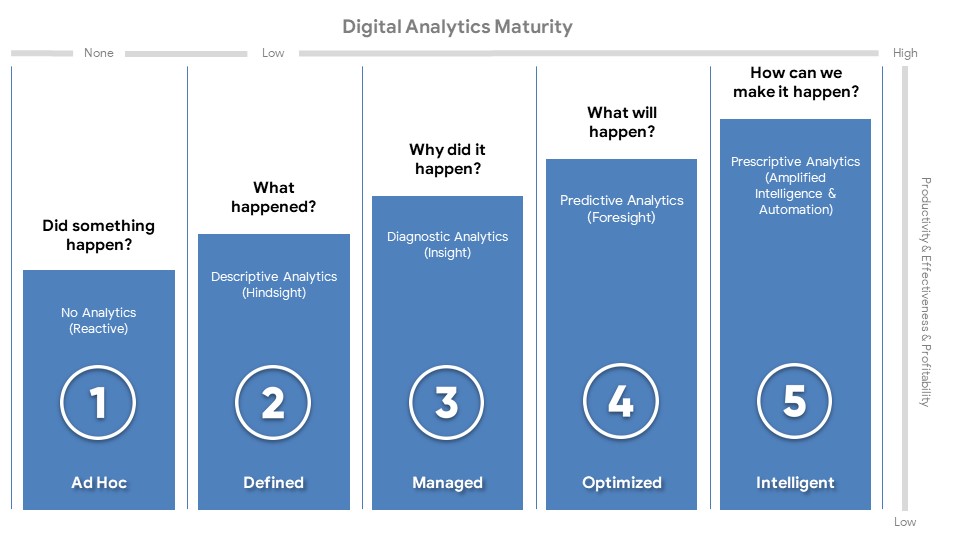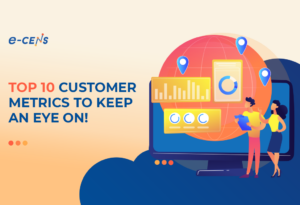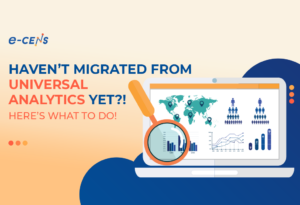In the digital age, businesses heavily rely on data-driven insights to make informed decisions. Digital analytics is the practice of analyzing digital data to gain insights and optimize business performance. However, not all businesses are created equal, and they do not all have the same level of digital analytics maturity. In this article, we will discuss what digital analytics maturity is, why it matters, and how to conduct a digital analytics maturity assessment to help businesses enhance their digital analytics capabilities.
What is Digital Analytics Maturity?
Digital analytics maturity refers to a business’s ability to effectively use digital analytics to achieve their strategic objectives. A business’s digital analytics maturity is determined by how effectively they are able to collect, analyze, and leverage digital data to inform decision-making. A business with high digital analytics maturity is able to use data-driven insights to optimize their digital operations, customer experience, and overall business performance.
Why Does Digital Analytics Maturity Matter?
Digital analytics maturity matters because it enables businesses to make data-driven decisions that lead to better outcomes. Without digital analytics, businesses are forced to make decisions based on assumptions and guesswork. This can lead to poor decision-making, wasted resources, and missed opportunities. By conducting a digital analytics maturity assessment, businesses can identify their strengths and weaknesses and develop a roadmap to enhance their digital analytics capabilities.
Basically, the higher the maturity level, the higher the effectiveness, productivity and profitability of a company.
The Five Stages of Digital Analytics Maturity
There are five stages of digital analytics maturity: Ad Hoc, Defined, Managed, Optimized, and Predictive. Let’s take a closer look at each stage.
1. Stage 1 – Ad Hoc
At the Ad Hoc stage, a business has no formal digital analytics program in place. Digital data is collected haphazardly, and there is no clear strategy for using it to inform decision-making. The Ad Hoc stage is characterized by a lack of data governance, limited data quality controls, and a lack of cross-functional collaboration.
At this stage, there’s literally no analytical strategy or framework and people are primarily acting reactively. Data is merely collected to gain a better understanding of reality, and typically, financial reports are the only available reports.
The main question to be answered here is “Did something happen?“.
2. Stage 2 – Defined
At the Defined stage, a business has some kind of a defined digital analytics program in place. There are clear policies and procedures for collecting and using digital data. The Defined stage is characterized by a focus on data quality, a structured approach to data governance, and cross-functional collaboration.
The data is primarily siloed and not easily available to a majority of staff, and the decision-making process does not rely on data analysis. Therefore, data is examined retrospectively to better understand and describe the past.
The main question to be answered here is “What happened?“.
3. Stage 3 – Managed
At the Managed stage, a business has a mature digital analytics program in place. There are formal processes for collecting and using digital data, and there is a strong focus on data quality and governance. The Managed stage is characterized by cross-functional collaboration, a focus on continuous improvement, and the use of advanced analytics techniques.
At this point, businesses begin to acknowledge the importance of analytics and incorporate technology to interpret data in a more precise and effective manner, thereby enhancing their decision-making processes. They build several key performance indicators (KPIs) and monitor them consistently.
The main question to be answered here is “Why did it happen?“.
4. Stage 4 – Optimized
At the Optimized stage, a business has a highly mature digital analytics program in place. There is a strong focus on data-driven decision-making, and digital data is used to optimize every aspect of the business. This will lead to prediction capabilities and enable the business to provide forecasts.
The Optimized stage is characterized by a data-driven culture, advanced analytics capabilities, and a focus on continuous improvement.
The main question to be answered here is “What will happen?“.
5. Stage 5 – Intelligent
At the Intelligent stage, a business has the highest level of digital analytics maturity. They use advanced predictive analytics techniques to forecast future trends and make proactive decisions. The Intelligent stage is characterized by a data-driven culture, cross-functional collaboration, and the use of advanced technologies such as artificial intelligence and machine learning.
At this stage, analytics extends beyond predicting future outcomes by utilizing vast amounts of historical data, real-time data streams, and information about past decision outcomes to automatically recommend optimal courses of action and suggest options for optimization.
The main question to be answered here is “How can we make it happen?“.
How to Conduct a Digital Analytics Maturity Assessment?
Conducting a digital analytics maturity assessment involves evaluating a business’s current digital analytics capabilities and identifying areas for improvement. Here are the steps to conducting a digital analytics maturity assessment:
Step 1 – Define Your Objectives
The first step in conducting a digital analytics maturity assessment is to define your objectives. What do you hope to achieve through the assessment? What are your key performance indicators (KPIs)?
Step 2 – Identify Key Performance Indicators (KPIs)
Identify the KPIs that are important to your business. These KPIs will help you measure your progress and identify areas for improvement.
Step 3 – Evaluate Your Current Analytics Capabilities
Evaluate your current digital analytics capabilities and assets. This can be done by conducting interviews with a statistical relevant number of employees throughout the company to receive a qualitative input. In addition, a survey should also be done with at least the triple amount of individuals to be involved. And last but not least, the technology currently in use also needs to be assessed. All this will then answer questions like:
- How are you collecting and analyzing digital data?
- What tools and technologies are you using?
- Are there any gaps or limitations in your current capabilities?
Step 4 – Identify Gaps and Opportunities
Identify the gaps and opportunities in your current digital analytics capabilities. What areas need improvement? What new technologies or tools could you implement to enhance your digital analytics capabilities?
Step 5 – Develop a Roadmap for Improvement
Based on your assessment, develop a roadmap for improving your digital analytics capabilities. This roadmap should include specific goals, timelines, and action items.
4 Benefits of Digital Analytics Maturity Assessment
Conducting a digital analytics maturity assessment offers several benefits, including:
1. Enhanced decision-making: By improving your digital analytics capabilities, you can make better, data-driven decisions.
2. Increased efficiency: Digital analytics can help you identify areas where you can streamline your operations and reduce costs.
3. Improved customer experience: By leveraging digital data, you can enhance the customer experience and improve customer satisfaction.
4. Competitive advantage: Businesses with high digital analytics maturity have a competitive advantage over those with lower maturity levels.
Conclusion
Digital analytics is critical to the success of businesses in the digital age. Conducting a digital analytics maturity assessment can help businesses enhance their digital analytics capabilities and make better, data-driven decisions. By following the steps outlined in this article, businesses can evaluate their current digital analytics capabilities, identify areas for improvement, and develop a roadmap for enhancing their digital analytics maturity.
Our consultants are here to help you build the right data analytics framework for your needs: contact E-cens today to learn more.
FAQs
-
- How long does it take to conduct a digital analytics maturity assessment?
The time required to conduct a digital analytics maturity assessment depends on the size and complexity of the business, the scope of the assessment, and the availability of data. It can take several weeks or months to complete. - Can small businesses benefit from a digital analytics maturity assessment?
Yes, small businesses can benefit from a digital analytics maturity assessment by gaining insights into their digital analytics capabilities, identifying areas for improvement, and optimizing their digital marketing efforts. - Can a digital analytics maturity assessment replace the need for digital marketing expertise?
No, a digital analytics maturity assessment is a tool for evaluating digital analytics capabilities and identifying areas for improvement. It does not replace the need for digital marketing expertise or strategic thinking. - What is the role of data governance in a digital analytics maturity assessment?
Data governance is essential for ensuring the accuracy and reliability of data used in a digital analytics maturity assessment. It involves defining data policies, standards, and procedures, and establishing roles and responsibilities for data management. - How can businesses ensure the sustainability of their digital analytics capabilities after conducting a digital analytics maturity assessment?
Businesses can ensure the sustainability of their digital analytics capabilities by developing a data-driven culture, investing in ongoing training and education, and continuously monitoring and improving their digital analytics practices. - How can businesses measure the success of their digital analytics maturity assessment?
Businesses can measure the success of their digital analytics maturity assessment by tracking improvements in key metrics such as website traffic, conversion rates, customer engagement, and revenue. They can also conduct periodic assessments to evaluate the impact of their digital analytics initiatives. - How can businesses incorporate digital analytics insights into their overall business strategy?
Businesses can incorporate digital analytics insights into their overall business strategy by aligning digital analytics goals with business objectives, developing actionable insights from data, and integrating digital analytics into decision-making processes. - Can businesses conduct a digital analytics maturity assessment on their own, or do they need to hire external experts?
Businesses can conduct a digital analytics maturity assessment on their own if they have the necessary expertise and resources. However, hiring external experts can provide additional insights and help ensure the accuracy and usefulness of the assessment. - What are the key benefits of conducting a digital analytics maturity assessment?
The key benefits of conducting a digital analytics maturity assessment include improving data-driven decision-making, enhancing customer engagement, optimizing digital marketing efforts, and driving business growth. - Can a digital analytics maturity assessment help businesses in highly regulated industries?
Yes, a digital analytics maturity assessment can help businesses in highly regulated industries by ensuring compliance with regulatory requirements, improving data security and privacy, and enhancing customer trust.
- How long does it take to conduct a digital analytics maturity assessment?






